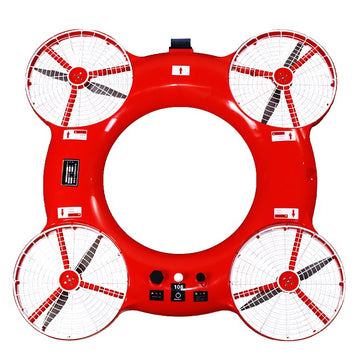Technological advancements have played a key role in improving the speed, efficiency, and effectiveness of lifesaving actions in the field of water emergency response and disaster management. Among these innovations, lifesaving drones have become a new trendsetter, changing the way we conduct Search and Rescue (SAR), medical aid, and risk assessment in crisis situations. This blog delves into the transformative potential of these aerial wonders, exploring how they are reshaping emergency response strategies and ultimately saving lives.
Rapid Search and Rescue
One of the most critical aspects of emergency response is the rapid location of persons in distress. Traditional search and rescue methods often rely on ground personnel, helicopters, or vessels, which may be hindered by challenging terrain, adverse weather conditions, or time constraints. Lifesaving drones equipped with high-resolution cameras, thermal imaging sensors, and advanced GPS technology excel in such scenarios. They can quickly scan large areas, penetrate dense foliage, navigate in rugged terrain, detect thermal signals of survivors, or precisely locate visual clues that might be missed by the human eye or traditional aviation equipment. This accelerated search capability significantly increases the chances of finding victims during the critical “golden hour,” when timely intervention can mean the difference between life and death.
Efficient Medical Supply Delivery
In remote or hard-to-reach locations, or in mass casualty incidents where ground channels are impacted, the delivery of basic medical supplies can be daunting. Drones designed for medical delivery purposes (also known as “air ambulances”) can bridge this gap. They carry blood products, medications, and even Automated External Defibrillators (AEDs), reaching patients, first responders, or remote medical facilities quickly. Some advanced models even incorporate stabilization mechanisms and climate-controlled compartments to ensure the integrity and effectiveness of sensitive medical cargo. By accelerating medical aid, these drones not only save lives but also alleviate the pressure on overburdened emergency services and infrastructure.
Water Emergency Rescue
The TY-3R water emergency rescue drone developed by DIDIOK MAKINGS is like a flying lifebuoy. It can be remotely controlled, has a flight speed of 13m/s, wind resistance of level 6, protection level of IP68, buoyancy up to 190N, and a coverage radius of 1 kilometer. It effectively solves the pain points of slow rescue speed and environmental impact, making rescue more efficient, safer, and smarter.
Real-time Situational Awareness
During disasters, obtaining accurate and up-to-date information about affected areas is crucial for effective decision-making and resource allocation. Lifesaving drones equipped with HD cameras, LiDAR sensors, and multispectral imaging capabilities provide real-time aerial surveillance and mapping. They can assess damage levels, determine safe routes for ground teams, detect secondary hazards such as gas leaks or structural instability, and monitor evolving threats such as wildfires or floods. This rich data is relayed back to the command center almost in real-time, enabling incident commanders to make wise, data-driven decisions, allocate resources more effectively, and prioritize rescue efforts based on the severity and urgency of each situation.
Communication Relay and Connectivity
In disaster-stricken areas where communication networks are disrupted, maintaining contact with survivors or coordinating rescue efforts becomes highly challenging. Drones equipped with wireless communication nodes can serve as aerial relays, extending network coverage to these isolated areas. They can establish temporary communication links for first responders, enabling them to communicate with each other, transmit important information to the command center, or even establish emergency call services for trapped or injured individuals. This enhanced connectivity aids in coordinating large-scale rescue operations, promoting rapid information exchange, and reassuring those waiting for help.
Future Prospects and Challenges
While lifesaving drones have already demonstrated their immense potential, ongoing research and development are expected to unlock more innovative applications. Future iterations may incorporate advanced artificial intelligence algorithms for autonomous target detection, swarm capabilities for large-scale search and rescue missions, or deployable rescue aids such as flotation devices or small first aid kits. However, the widespread adoption of these technologies also faces challenges, including regulatory obstacles, privacy concerns, and the need for standardized operating procedures and interoperability with existing emergency response systems.
In conclusion, lifesaving drones are redefining the landscape of emergency response, offering unparalleled speed, versatility, and situational awareness capabilities in times of crisis. As these aerial emissaries continue to evolve, they are expected to augment human efforts, shorten response times, and ultimately contribute to saving countless lives in peril. Undoubtedly, the future of emergency response is taking flight, with lifesaving drones at the forefront of this aerial revolution.





